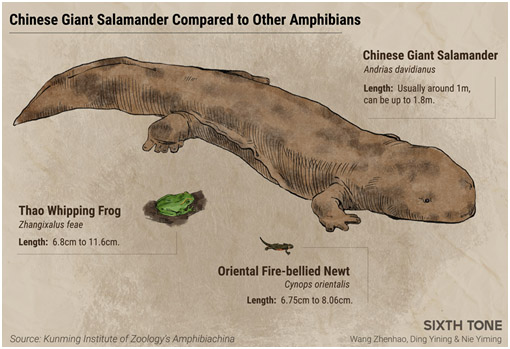|
At a length of two meters, the Chinese giant salamander (Andrias davidianus) is the largest species of amphibian. It is endemic to China. Once common and widespread, nowadays it is rare in the wild due to habitat destruction and overexploitation for food. The Chinese giant salamander is classified as Critically Endangered meaning at the verge of extinction. In China it is protected, and artificial breeding has been encouraged as a possible conservation measure. Captive breeding of this species, however, currently takes place almost exclusively in commercial farms. Second-generation offspring can be traded legally and individuals weighing two kilograms have been sold previously for more than $1,500. Today, millions of Chinese giant salamanders live in farms and their progeny have been released into local rivers as part of government-promoted conservation action.

The Chinese giant salamander has been historically recorded from fast-flowing tributaries of the Yellow, Yangtze, and Pearl River systems. It lives in rocky mountain streams and lakes with clear, running water, at moderate altitudes, where the salamanders occupy hollows and cavities under water. The salamander spends its whole life in water. The female lays approximately 500 eggs.
Since the 1980s, fourteen nature reserves have been established in Henan, Jiangxi, Chongquing city, Shaanxi, Guizhou and Hunan Provinces to protect wild Chinese giant salamander populations. However, protected areas have limited natural habitat left.
Multiple night surveys indicate that wild populations of the Chinese giant salamander are on the verge of extinction and that this endemic species will become extinct in China if no new and effective conservation actions are taken in the near future. For example, despite recent extensive field surveys, the Chinese giant salamander was not detected in Fanjingshan National Nature Reserve. Wild populations are threatened and some have already become extinct.
Endangered Species International is committed to address the rapid decline of amphibians worldwide throughout specific research and conservation projects, conservation awareness and outreach, strengthening and encouraging the creation of protected areas that cover the ranges of endangered amphibian species that are currently unprotected, and advising and assisting national and local authorities on protecting listed species and their habitats.
Related Links
|











